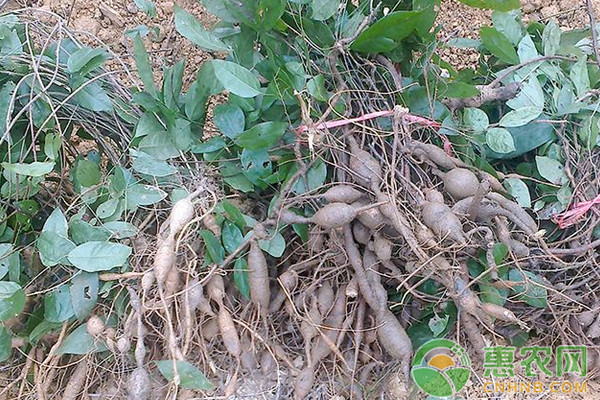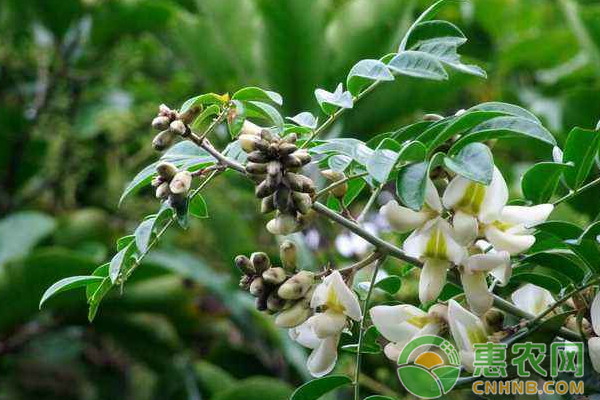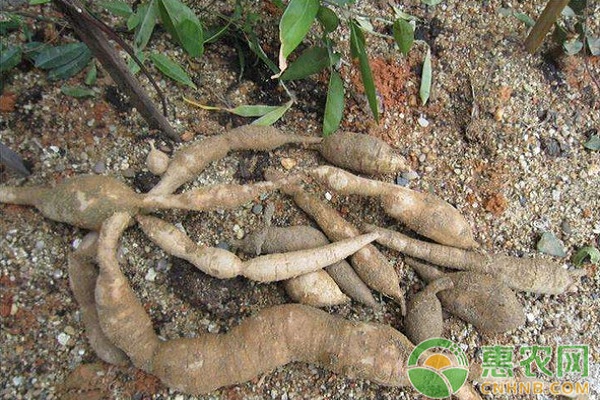How do cattle vigorously raise seedlings? The cow is vigorous, and the alias is inverted with the golden bell, the strong potato, the pig's ankle, the golden bell root, and the mountain lotus root. Indications for lumbar muscle strain, rheumatoid arthritis, treatment of lung heat, lung deficiency and cough. Let's take a look at the technical regulations for the production of the seedlings of the cattle under the small series.

1 Scope
This regulation stipulates the species selection, habitat environment, seedling technology, pest control, packaging and transplanting, packaging and transportation and archival records of the production of bovine seedlings. This regulation is applicable to the production of bovine vigorous seedlings in Guangxi Zhuang Autonomous Region.
2 Reference standard
The following documents are indispensable for the application of this document. For dated references, only the dated date applies to this document. For undated references, the latest edition (including all amendments) applies to this document.
NY/T 391-2000 Environmental Conditions for Green Food Origin
DB45/T 532-2008 Environmental conditions for the production of pollution-free Chinese herbal medicines
GB 3095-2012 Ambient Air Quality Standard
GB 15618-2008 Soil Environmental Quality Standard
GB 5084-2005 Farmland Irrigation Water Quality Standard
NY/T 394-2013 Green Food Fertilizer Use Guidelines
NY/T 496-2010 General Principles for the Rational Use of Fertilizers
GB 4285-1989 Standard for safe use of pesticides
GB/T 8321.1-GB/T 8321.9 (all parts) guidelines for the rational use of pesticides
NY/T 393-2013 Guidelines for the Use of Green Food Pesticides
NY/T 658-2015 General Guidelines for Green Food Packaging
NY/T 1056-2006 Green Food Storage and Transportation Guidelines
3 species selection
Bean branch butterfly flower subfamily yam vine plant beautiful cliff bean vine.
4 Origin environment
Meet the requirements of NY/T 391-2000, DB45/T 532-2008, GB 3095-2012, GB 15618-2008 and GB 5084-2005 [18]. Choose a gentle block that is far away from the source of pollution, convenient for irrigation and drainage, and leeward to the sun.
5 seedling technology
5.1 Principles of fertilizer use
Meets the requirements of NY/T 394-2013 [19] and NY/T 496-2010. When conditions permit, try to choose a fully decomposed organic fertilizer.
5.2 Seed Preparation
5.2.1 Seed selection
A high-yield single plant with no pests and diseases, good growth and relatively mature maturity was selected as the parent strain.
From November to December, when the bovine fruit pods turn from green to brown or tan, and the water content is ≤20%, the pods are collected and air-dried at room temperature with a dry air and a relative humidity of 30% to 50%. ≤ 2 cm, time 5 to 7 d; after the pods are dried, the pods are removed, the seeds are removed, and the seeds with uniform texture, full grain, and no eggs are selected, and dried in an environment of 8-12 ° C without light. (2~3 d). Seed quality requirements: germination rate ≥ 80%, purity ≥ 95%, clarity ≥ 99%, water content ≤ 13%.
5.2.2 Seed treatment
First, the seeds and pure water are mixed in a volume ratio of 1:1.5, and then stirred at a speed of 80 to 100 r/min. The seeds that have settled on the bottom of the water are allowed to dry slightly. Then, soak the seeds in 5% sodium hypochlorite solution for 20-25 min, then soak in 15% trisodium phosphate solution for 30-40 min, wash well and dry slightly. Finally, the seeds were placed in warm water at 30 ° C for 24 h and dried slightly.

5.3 germination
The river sand is mixed according to the mass ratio of 45-60 mesh: 30-45 mesh: 20-30 mesh = 3:10:2, and poured into a seedbed having a width of 1 to 1.5 m to form a height of 6 to 10 cm. The germination bed is further covered with a layer of 1-2 cm of river sand (45-60 mesh), and disinfected with 95% dixon 300 times solution or methyl thiophanate 1000 times solution to water.
The treated seeds are evenly spread on the sand bed, covered with a layer of 1.0-1.5 cm wet river sand (60 mesh, the humidity is held in groups by hand, and it is suitable for touching). Set up a 60-80 cm high arch shed, covered with white plastic film, compacted around to prevent wind and rain, until the seeds are white. During the germination period, the water content of the river sand is kept at 75% to 85%; when the temperature outside the shed is ≥23 °C, the film is ventilated.
5.4 Nursery
Select the red loam soil to remove the surface layer, crush, pass 80-100 mesh sieve, spray 0.2% potassium permanganate solution, add 2% quicklime, mix well to make a heap, cover with plastic film and seal, suffocate for 5-7 days. The soil is packed in a non-woven seedling bag of 6 to 8 cm (upper mouth diameter) × 10 to 12 cm (height), and the soil height is 7 to 9 cm. The white seeds were spotted in a seedling bag, one bag per bag, the umbilical cord was turned down, and the sifted red loam with a thickness of 2 to 3 cm was sown after sowing.
The seedling bags are arranged closely on the seedling plots with a width of 1.2-1.4 m, and the water is drenched. A shed with a height of 1.8 to 2 m is placed, covered with a white plastic film, and compacted around to prevent wind and rain.

5.5 Seedling management
5.5.1 Replenishing seedlings
Check on the 30th day after the on-demand, if the death is found, the seeds will be cleared and replenished in time.
5.5.2 Water Management
The bovine vigorous seedlings are slightly drought-tolerant and resistant to cockroaches. When they are subjected to cockroaches, the leaves of the seedlings gradually turn yellow, the leaves are dull, and when they are severe, they dry and fall off, and the new leaves are difficult to germinate. Therefore, pay attention to watering during drought and drain in time after rain to keep the soil moist. If the whole seedling is exposed, the seedling should be planted immediately and transplanted to other nursery plants with low humidity for routine management.
5.5.3 Fertilization and weeding
After the true leaves grow, the decomposed organic fertilizer water is applied once every 30 days. Combined with fertilization, artificial weeding is carried out to prevent weeds and seedlings from competing for fertilizer.
5.5.4 Deficiency management
Bovine vigorous seedlings are prone to iron deficiency, which is characterized by yellowing of leaves, chlorosis between veins, and new leaves are particularly serious. Spray with 1/5MS iron salt and spray 3 times to relieve symptoms and restore new leaves.
6 pest control
6.1 Principles of Prevention
Carry out the requirements of plant protection work of “prevention first, comprehensive preventionâ€, and adhere to the principle of “agricultural prevention, physical control, biological control, supplemented by chemical prevention and controlâ€. When it is really necessary to use chemical agents, it is necessary to strictly implement the relevant provisions of GB/T 8321.1-GB/T 8321.9 and NY/T 393-2013.
6.2 Agricultural control
Select excellent varieties resistant to diseases and insects, as well as seeds without pests and diseases, cultivate strong seedlings; scientific water and fertilizer management; timely removal of diseased plants; timely fertilization and weeding.
6.3 Physical control
For phototaxis pests such as Chilo suppressalis, Scarab and Spodoptera litura, black light or frequency-vibration insecticidal lamp can be used to trap; aphids can be trapped by yellow glue board; for underground pests such as cockroaches, crickets, tigers and giant salamanders, Wine: Sugar: vinegar: water: 90% trichlorfon crystal = 0.5:1:2:10:0.5, the sweet and sour liquid was trapped.
6.4 Biological control
Release natural enemies, such as killing mice with owls; using biological pesticides to control pests and diseases, such as for bacterial diseases, can be controlled with 800 million/g effective viable counts of Bacillus polymyxa 800-1000 times, and for twill nights Phototaxis pests such as moths can be trapped with 0.3% azadirachtin 1 000 to 1 200 times solution or 10% Bt emulsion at 1,500 to 2,000 times.
6.5 Chemical control
6.5.1 Stem rot
Mainly caused by Rhizoctonia, the symptoms are the wilting of the upper part of the seedlings, brown or transparent lesions at the base of the stem, and then the roots rot. The disease often occurs in pieces, causing a large number of dead seedlings. Before transplanting, 50% chlorhexidine WP, 50% dexamethasone WP, 50% carbendazim WP, 70% chlorothalonil WP or 70% WP 1500 can be used. ~800 times liquid spray prevention. After transplanting, gradually reduce the soil moisture. Once the disease has occurred, the diseased plant is immediately removed and the above-mentioned agent is used to drench the affected area.
6.5.2 Anthrax
Spraying 50% carbendazim wettable powder 800~1 000 times, or 75% methyl thiophanate wettable powder 1 000~1 200 times, combined with spraying new high-fat film can significantly enhance the control effect.
6.5.3 Leaf moth
The hatched larvae begin to forage from the young leaves and then the new leaves. Most of the leaves after being foraging only leave veins, which seriously affects the growth of seedlings. It can be sprayed with 2.5% Avi-Flutonium emulsifiable concentrate, 5% Avicidin granules or 5% Avermectin emulsifiable concentrate in the initial stage.
6.5.4 Locust
Spray the leaves at 1,500 to 2,000 times solution of 3% Mobilan emulsifiable concentrate or 2,000 to 2,500 times of 50% anti-Converse WP.
6.5.5 phytotoxicity
The phytotoxicity is mainly caused by the application of excessive pesticides. The symptoms are characterized by leaf shrinkage, yellowing of new leaves, and dryness and shedding in severe cases. The prevention and treatment method is to avoid spraying at high temperature and glare time, and according to the concentration indicated by the medicament, once the signs of phytotoxicity are found, the water spray is rinsed in time to reduce the phytotoxicity.
7 refining and transplanting
Before transplanting, root treatment was carried out, that is, the root system of the bottom of the bag was cut off and managed normally for 1 week. Then, gradually increase the light intensity, reduce the air humidity, and reduce the amount of water to reduce the substrate humidity. When the seedling height is ≥15 cm, it can be transplanted. Spraying 50% carbendazim WP 500 times solution for sterilizing 1 to 2 days before transplanting.
8 packaging and transportation
Meets the requirements of NY/T 658-2015 and NY/T 1056-2006. In the process of transporting cattle vigorously from nursery to planting, the transportation tools and loading tools used must be non-toxic and non-polluting. Covering seedlings with shading materials to prevent exposure to sunlight and water loss; Pay attention to ventilation to prevent the seedlings from sultry and rot.
9 file records
Detailed records of the measures taken in the selection of species, environment of the place of origin, seedling technology, pest control, seedling transplanting, packaging and transportation, and archival records, and the establishment of archives.
The above is all about the cattle vigorously, welcome everyone to continue to pay attention to Hui Nong network!
Others Oxygen Generator,Pressure Swing Adsorption Oxygen Making Machine,Psa Oxygen Making Machine,Oxygen Producing Machine
Hangzhou Zhongju air separation equipment manufacturing Co., Ltd , https://www.hzzjkfzz.com